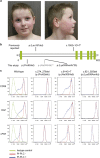Cerebral visual impairment and intellectual disability caused by PGAP1 variants
- PMID: 25804403
- PMCID: PMC4795198
- DOI: 10.1038/ejhg.2015.42
Cerebral visual impairment and intellectual disability caused by PGAP1 variants
Abstract
Homozygous variants in PGAP1 (post-GPI attachment to proteins 1) have recently been identified in two families with developmental delay, seizures and/or spasticity. PGAP1 is a member of the glycosylphosphatidylinositol anchor biosynthesis and remodeling pathway and defects in this pathway are a subclass of congenital disorders of glycosylation. Here we performed whole-exome sequencing in an individual with cerebral visual impairment (CVI), intellectual disability (ID), and factor XII deficiency and revealed compound heterozygous variants in PGAP1, c.274_276del (p.(Pro92del)) and c.921_925del (p.(Lys308Asnfs*25)). Subsequently, PGAP1-deficient Chinese hamster ovary (CHO)-cell lines were transfected with either mutant or wild-type constructs and their sensitivity to phosphatidylinositol-specific phospholipase C (PI-PLC) treatment was measured. The mutant constructs could not rescue the PGAP1-deficient CHO cell lines resistance to PI-PLC treatment. In addition, lymphoblastoid cell lines (LCLs) of the affected individual showed no sensitivity to PI-PLC treatment, whereas the LCLs of the heterozygous carrier parents were partially resistant. In conclusion, we report novel PGAP1 variants in a boy with CVI and ID and a proven functional loss of PGAP1 and show, to our knowledge, for the first time this genetic association with CVI.
Figures

References
-
- Boonstra N, Limburg H, Tijmes N, van Genderen M, Schuil J, van Nispen R: Changes in causes of low vision between 1988 and 2009 in a Dutch population of children. Acta Ophthalmol 2012; 90: 277–286. - PubMed
-
- Rahi JS, Cable N: Severe visual impairment and blindness in children in the UK. Lancet 2003; 362: 1359–1365. - PubMed
-
- Dutton GN, Jacobson LK: Cerebral visual impairment in children. Semin Neonatol 2001; 6: 477–485. - PubMed
-
- Bosch DG, Boonstra FN, Reijnders MR, Pfundt R, Cremers FP, de Vries BB: Chromosomal aberrations in cerebral visual impairment. Eur J Paediatr Neurol 2014; 18: 677–684. - PubMed
Publication types
MeSH terms
Substances
Grants and funding
LinkOut - more resources
Full Text Sources
Other Literature Sources
Medical
Molecular Biology Databases
Research Materials
Miscellaneous

